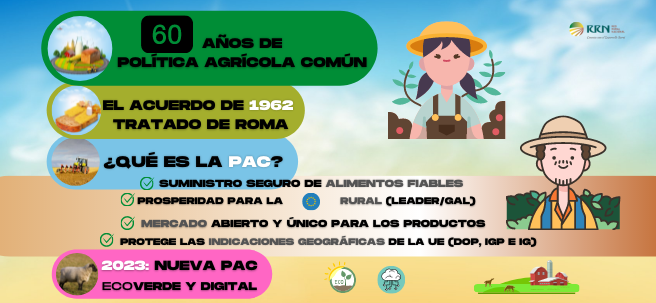
15 de February de 2022
Cambio climático y gestión de recursos naturales
- The CAP was born with the Treaty of Rome in 1962, which contains the essential objectives of the Common Agricultural Policy that are still in force.
- The 60th anniversary coincides with the launch of the new CAP for the period 23-27
- The CAP has evolved over decades to respond to a changing market, and today, to factors such as climate change and the need for sustainable development.
For decades, Europe has enjoyed a wide variety of high-quality, high-safety foods. This hasn't always been the case.
It was the European Union's (EU) Common Agricultural Policy (CAP) that, following the devastation and famine caused by World War II, introduced rules for Member States that would support the agricultural sector in order to protect both consumers and producers.
Specifically, it was in 1962 that the ministers of the six founding countries of the then-called European Communities (Germany, France, Italy, the Netherlands, Belgium, and Luxembourg) concluded the agreement that provides legal basis for the first Common Agricultural Policy in Europe. Its original objectives are enshrined in the Treaty of Rome and remain at the heart of the CAP today:
- Increase productivity and stabilize markets
- Ensure the availability of food at reasonable prices
- Providing a fair standard of living for farmers
In the early 2000s, as the EU expanded eastward, a new pillar of the CAP was introduced that would contribute to the livelihoods of communities in rural and mountainous areas. This pillar is rural development.
The CAP and rural development
Rural development financing supports the primary sector in less populated areas and aims to revitalize rural areas . It also contributes to making remote and mountainous areas more livable by facilitating the development of infrastructure and basic services (health, education, etc.).
The key method for achieving these goals is called LEADER . With this approach, people from the communities themselves become personally involved in designing and implementing their own strategies, as well as in decision-making and resource allocation for the development of their rural areas.
Local Action Groups (LAGs) are the vehicle for the LEADER approach. Through these non-profit public-private entities, local individuals and organizations channel their financial resources to benefit the region, enabling a bottom-up approach to the use of funds allocated to that community.
In recent years, innovation has become another essential element. Through the Operational Groups and their innovative projects , a significant amount of applied knowledge is being developed to solve the specific problems facing the agricultural, food, and forestry sectors in different parts of Europe, as well as connecting key players.
Key features of the CAP
Basically, what is the CAP today?
- A secure food supply
Existing CAP regulations are key to ensuring food production and distribution during a crisis, as demonstrated during the COVID-19 pandemic. In addition to greater flexibility in logistics regulations, farmers and rural development beneficiaries received advances, state aid, and loans on favorable terms. Exceptionally, unused funds under the Rural Development Programs were made available to those particularly affected.
- Support for the sector and its growth
Through direct payments , the CAP ensures that farmers receive payments based on the area they cultivate, not their production, which fluctuates depending on weather conditions.
- An open market for products
As the CAP evolved, a single common market was created for all products, with no more price interventions. This allows European farmers to distribute their products across national borders.
- Protection of technical knowledge
The EU has a rich supply of high-quality local and regional foods, the fruit of a long tradition and expertise. EU geographical indications (PDO, PGI, and GI) recognize the intellectual property rights of certain products, protecting them from imitation and misuse. They are also marketing tools that help consumers recognize quality products.
New CAP
The new CAP, which will come into force in 2023, aims to contribute to an improvement in the environment and climate by rewarding environmentally friendly agriculture, which is not normally compensated by the markets. The new "eco-schemes" will be funded by 25% of each Member State's allocation for direct payments.
Likewise, digitalization , technological innovation , and research are being put at the service of agriculture to make it sustainable. And, for the first time, the gender perspective is included in the definition of the CAP.
All of this is led by the younger generations, without whom it is impossible to achieve generational change in the countryside. Hence, the CAP 2023-2027 includes new measures to encourage young people to enter the agri-food sector and participate in the development of rural areas. These measures are translated into direct subsidies or loans.









